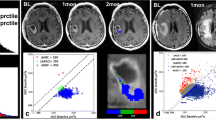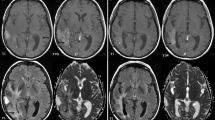Abstract
While patients with recurrent glioblastoma receiving anti-angiogenic therapy demonstrate significant response rates, the benefit on patient survival is less clear. We assessed whether histogram analysis of diffusion weighted MRI can stratify for progression-free and overall survival. Baseline and 3–6 week post-treatment MRI exams of 91 patients with recurrent glioblastoma treated with bevacizumab were retrospectively evaluated. Histograms of apparent diffusion coefficient (ADC) within the volume of contrast enhancing and nonenhancing T2/FLAIR lesions were analyzed using curve-fit analysis. Overall survival (OS) and progression-free survival (PFS) were assessed using ADC parameters in a Cox proportional hazards model adjusted for clinical variables. Baseline ADCL/ADCM within nonenhancing T2/FLAIR volume (> or ≤0.64) can stratify OS (HR = 2.24, p = 0.002) and PFS (HR = 1.90, p = 0.005). %ADCH within enhancing T1+C volume (> or ≤25 %) can also stratify OS (HR = 0.59, p = 0.034) and PFS (HR = 0.56, p = 0.01). Stratification of patient survival can be improved by merging these two ADC parameters into a single combined ADC factor (HR = 0.17, p < 0.0001). The median OS ratio of patient groups stratified by this combined factor was 2.03, larger than median OS ratio when stratifying by either %ADCH within T1+C volume alone (1.3) or ADCL/ADCM within T2/FLAIR alone (1.86). ADC histogram analysis within both enhancing and nonenhancing components of tumor can be used to stratify for PFS and OS in patients with recurrent glioblastoma.



Similar content being viewed by others
References
Norden AD, Drappatz J, Muzikansky A, David K, Gerard M, McNamara MB, Phan P, Ross A, Kesari S, Wen PY (2009) An exploratory survival analysis of anti-angiogenic therapy for recurrent malignant glioma. J Neurooncol 92:149–155
Kreisl TN, Kim L, Moore K et al (2009) Phase II trial of single-agent bevacizumab followed by bevacizumab plus irinotecan at tumor progression in recurrent glioblastoma. J Clin Oncol Off J Am Soc Clin Oncol 27:740–745
Friedman HS, Prados MD, Wen PY et al (2009) Bevacizumab alone and in combination with irinotecan in recurrent glioblastoma. J Clin Oncol Off J Am Soc Clin Oncol 27:4733–4740
Yamasaki F, Kurisu K, Satoh K et al (2005) Apparent diffusion coefficient of human brain tumors at MR Imaging1. Radiology 235:985–991
Provenzale JM, McGraw P, Mhatre P, Guo AC, Delong D (2004) Peritumoral brain regions in gliomas and meningiomas: investigation with isotropic diffusion-weighted mr imaging and diffusion-tensor MR Imaging1. Radiology 232:451–460
Sugahara T, Korogi Y, Kochi M et al (1999) Usefulness of diffusion-weighted MRI with echo-planar technique in the evaluation of cellularity in gliomas. J Magn Reson Imaging JMRI 9:53–60
Pope WB, Lai A, Mehta R et al (2011) Apparent diffusion coefficent histogram analysis stratifies progression-free survival in newly diagnosed bevacizumab-treated glioblastoma. AJNR Am J Neuroradiol. doi:10.3174/ajnr.A2385
Pope WB, Kim HJ, Huo J et al (2009) Recurrent glioblastoma multiforme: ADC histogram analysis predicts response to bevacizumab treatment. Radiology 252:182–189
Pope WB, Qiao XJ, Kim HJ et al (2012) Apparent diffusion coefficient histogram analysis stratifies progression-free and overall survival in patients with recurrent GBM treated with bevacizumab: a multi-center study. J Neurooncol 108:491–498
Ellingson BM, Malkin MG, Rand SD, LaViolette PS, Connelly JM, Mueller WM, Schmainda KM (2011) Volumetric analysis of functional diffusion maps is a predictive imaging biomarker for cytotoxic and anti-angiogenic treatments in malignant gliomas. J Neurooncol 102:95–103
Ellingson BM, Cloughesy TF, Lai A, Mischel PS, Nghiemphu PL, Lalezari S, Schmainda KM, Pope WB (2011) Graded functional diffusion map-defined characteristics of apparent diffusion coefficients predict overall survival in recurrent glioblastoma treated with bevacizumab. Neuro-Oncology 13:1151–1161
Jain R, Scarpace LM, Ellika S, Torcuator R, Schultz LR, Hearshen D, Mikkelsen T (2010) Imaging response criteria for recurrent gliomas treated with bevacizumab: role of diffusion weighted imaging as an imaging biomarker. J Neurooncol 96:423–431
Saraswathy S, Crawford FW, Lamborn KR, Pirzkall A, Chang S, Cha S, Nelson SJ (2009) Evaluation of MR markers that predict survival in patients with newly diagnosed GBM prior to adjuvant therapy. J Neurooncol 91:69–81
Crawford FW, Khayal IS, McGue C, Saraswathy S, Pirzkall A, Cha S, Lamborn KR, Chang SM, Berger MS, Nelson SJ (2009) Relationship of pre-surgery metabolic and physiological MR imaging parameters to survival for patients with untreated GBM. J Neurooncol 91:337–351
Wen PY, Macdonald DR, Reardon DA et al (2010) Updated response assessment criteria for high-grade gliomas: response assessment in neuro-oncology working group. J Clin Oncol Off J Am Soc Clin Oncol 28:1963–1972
Huang RY, Rahman R, Hamdan A, Kane C, Chen C, Norden AD, Reardon DA, Mukundun S, Wen PY (2013) Recurrent glioblastoma: volumetric assessment and stratification of patient survival with early posttreatment magnetic resonance imaging in patients treated with bevacizumab. Cancer. doi:10.1002/cncr.28210
Pieper S, Lorensen B, Schroeder W et al. (2006) The NA-MIC Kit: ITK, VTK, pipelines, grids and 3D slicer as an open platform for the medical image computing community. In: 3rd IEEE International Symposium on Biomedical Imaging: Macro to Nano, 2006, pp 698–701.24
Pieper S, Halle M, Kikinis R (2004) 3D SLICER. Proceedings of the 1st IEEE International Symposium on Biomedical Imaging: from Nano to Macro 2004, pp 632–635
Provenzale JM, Mukundan S, Barboriak DP (2006) Diffusion-weighted and perfusion MR imaging for brain tumor characterization and assessment of treatment response. Radiology 239:632–649
Morita K, Matsuzawa H, Fujii Y, Tanaka R, Kwee IL, Nakada T (2005) Diffusion tensor analysis of peritumoral edema using lambda chart analysis indicative of the heterogeneity of the microstructure within edema. J Neurosurg 102:336–341
Norden AD, Young GS, Setayesh K et al (2008) Bevacizumab for recurrent malignant gliomas: efficacy, toxicity, and patterns of recurrence. Neurology 70:779–787
Gerstner ER, Frosch MP, Batchelor TT (2009) Diffusion magnetic resonance imaging detects pathologically confirmed, nonenhancing tumor progression in a patient with recurrent glioblastoma receiving bevacizumab. J Clin Oncol 28:e91–e93
Rieger J, Bähr O, Müller K, Franz K, Steinbach J, Hattingen E (2010) Bevacizumab-induced diffusion-restricted lesions in malignant glioma patients. J Neurooncol 99:49–56
Kang Y, Choi SH, Kim Y-J, Kim KG, Sohn C-H, Kim J-H, Yun TJ, Chang K-H (2011) Gliomas: histogram analysis of apparent diffusion coefficient maps with standard- or high-b-value diffusion-weighted mr imaging—correlation with tumor grade. Radiology 261:882–890
Acknowledgments
None.
Conflict of interest
Drs. Wen and Reardon have research support and have served on an advisory board for Genentech.
Author information
Authors and Affiliations
Corresponding author
Rights and permissions
About this article
Cite this article
Rahman, R., Hamdan, A., Zweifler, R. et al. Histogram analysis of apparent diffusion coefficient within enhancing and nonenhancing tumor volumes in recurrent glioblastoma patients treated with bevacizumab. J Neurooncol 119, 149–158 (2014). https://doi.org/10.1007/s11060-014-1464-8
Received:
Accepted:
Published:
Issue Date:
DOI: https://doi.org/10.1007/s11060-014-1464-8




